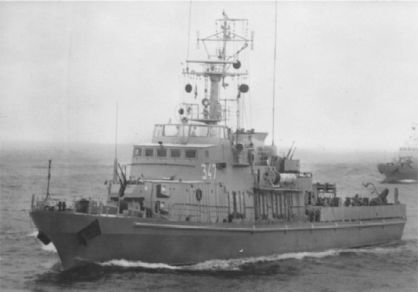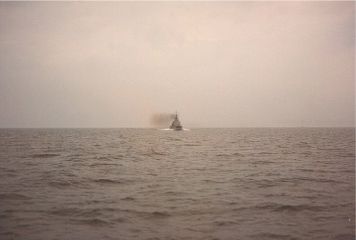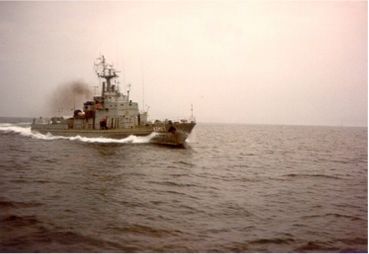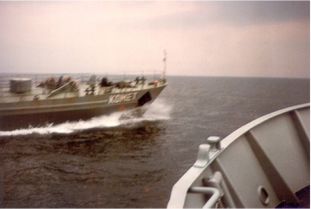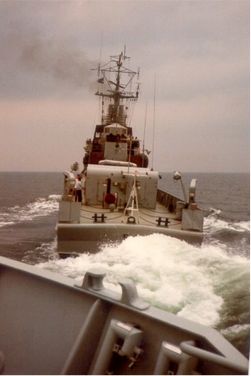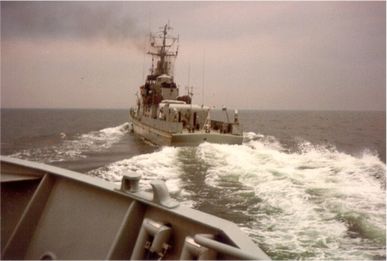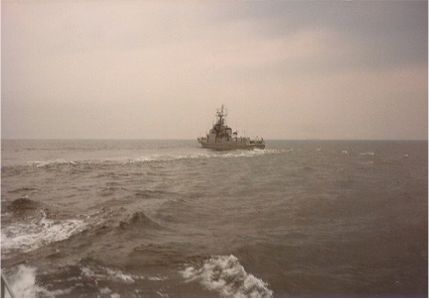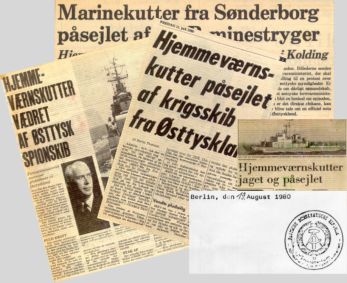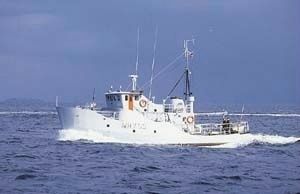|
You are here: 4Campaigns & Battles4Index4The Battle off Gedser |
||||||||||||||||||||
|
The Battle off Gedser (1980):
It was an East German minesweeper of the
KONDOR-class, as shown above, East German Minesweeper rams Danish Home Guard CutterThe
Naval home guard cutter MHV 94 was July 8, 1980 rammed by an
East German minesweeper. In the diplomatic game, the two sides in the incident was standing firmly on their story, in spite of the pictures telling the true story of the incident at Gedser. These incidents wasn’t uncommon, during the entire duration of “The Cold War”, and already earlier that same year, a Danish minelayer and a Russian frigate had a collision. By Leo Bram/translated by Jakob Dalgaard On July 8, 1980, the Naval Home Guard cutter MHV 94, with crewmembers from the 136th Home Guard Flotilla in Sønderborg embarked, left Lübeck, heading for the naval base at Holmen in Copenhagen. On a south-easterly heading, south of Gedser, MHV 94 observed an East German naval vessel, a KONDOR-class Mine Sweeper. The KONDOR-class trailed along on the starboard side of MHV 94, at a distance of 2,2 nautical miles for approximately 2 hours, then the vessel increased speed and overtook MHV 94.
On
a south-easterly heading, south of Gedser, an East German naval vessel, After a while, the KONDOR-class turned port and steamed directly towards MHV 94 from a distance of a couple of miles. The bearing didn't change The KONDOR-Class were checked several over the compass for changes in the bearing from MHV 94, but the bearing didn’t change. The thick black smoke, rising from the chimney, and the large wave from the bow, revealed that the KONDOR-Class had increased its speed considerably, properly 20-24 knots. At that time, I came up on the foredeck, with my camera, and realized that a WAPA (Warsaw-pact) vessel was heading straight towards us, and would come very close to MHV 94, maybe so close that I could take some nice close-up of the ship. Master of the vessel, Svend Elefsen, that were on duty on the bridge as navigator, realized that the KONDOR-Class came closer with high speed, and that a anti-collision-situation was imminent. MHV 94 was on a steady course and speed, as prescribed in "International Rules of The Sea".
The KONDOR-class mine sweeper is heading straight toward the MHV
94. On the foredeck, I began taking a series of pictures of the KONDOR-Class as is came closer and closer. At approximately 100 meter, the KONDOR-Class changed its course a bit towards port in order to pass close to the bow of MHV 94. Across the bow of MHV 94 and in contradiction to the rules of the sea A manoeuvre, crossing in front of another vessel are against the rules of the sea and good seamanship. When the bow of the KONDOR-Class was directly aligned with the bow of MHV 94, I took a picture.
KOMET
heads directly in front of MHV 94 and a collision seems almost
unavoidable. The name of the ship, KOMET, was written on the bow of the ship. KOMET was going high speed, and it directly occurred to me, that a collision was unavoidable. I let got of my camera, so that it hanged in its strap, and grasped the railing with both hands. The long slender vessel raced in front of our bow at a distance of 5 – 10 meters. When the bridge of the KOMET was directly aligned with the bow of MHV 94, a door on the starboard side opened, and an officer in his mid-twenties came out. For a split second, our eyes met, but no salutes or smiles were exchanged from either side. The officer then looked aft along his vessel.
As I
saw it, there was the expression of surprise painted in the mans face, when he
realized that a collision was unavoidable. He quickly returned to the wheelhouse
where a fatal command to the helmsman was given.
The KOMET turned port and her stern swung into the bow of MHV 94. If the master had maintained his course, or had turned starboard, a collision could might be avoided, but this was not to be. The Collision A loud crash, and MHV 94 rolled heavily to starboard, and at the same time, it was thrown 180° to an opposite course. The bow of MHV 94 hit the bulwark of the KOMET and it was bend inwards for 5-10 meters. The bow of MHV 94 grated along the side of the KOMET, until the two vessels were free from each other. Not thinking about it, I raised the camera and took a picture of the KOMET from the rear, when it was heading away, high speed. This photo was displayed in Ekstra Bladet (a Danish newspaper) a couple of days later on page 2. KOMET slowed down shortly after the crash, and lay dead in the water at a distance of 3-400 meters.
KOMET steaming full speed away from the place
of the collision. In the collision MHV 94 received a dent and a hole in the bow, between the waterline and the free deck. The hole was adjacent to the anchor chain guard, and their was no danger of flooding. No one onboard was hurt. Enroute Holmen with a hole in the stern Master Svend Elefsen contacted the duty officer at Admiral Danish Fleet headquarter via Lyngby Radio who told him not to contact KOMET, and proceed directly towards Holmen.
KOMET disappears from the collision site
without further contact to MHV 94. A night the wind increased in strength, and every time our stern hit the waves MHV 94 drank a bit of seawater, but no more than our pumps could keep up. We arrived at Takkeloftsgraven at Holmen in radiant sunshine the next morning. Interrogations in Copenhagen The master, the helmsman Eiler Jepsen and yours truly had been summoned to immediate meetings with the naval intelligence service and the naval home guard command. It's pretty exciting to meet these offices as a "key person". The naval intelligence mostly wants to hear about the technical details, whereas the home guard command, wants to know who did what and clarify who was to blame for the incident.
An extract of the many Danish newspaper commentary. My film are being confiscated as secret evidence, but no more secret than the newspaper "Ekstra Bladet" gets hold of one of the pictures. We are ordered not to talk to the press. Our explanations are taken into considerations, and with the evidence presented, our backs are cleared. There's no doubt in our mind that KOMET didn't observe the rules of the sea and made way. KOMET furthermore went in front of us, and the collision was unavoidable, even if the Master was reversing at full throttle in the last minute. It is pointed out, that there wasn't given 5 short blows with the horn, from MHV 94 meaning ”What are your intensions”, - but Svend apparently hadn't got the time to do so. Fierce diplomatic activity In the time following the incident, several letters are going back and forth between the East German and Danish authorities, but it is clear to the East Germans that MHV 94 are to be blamed for the incident.
Obviously the East German wanted the case presented as a overtaking manoeuvre, but this is not in accordance with the pictures, showing KOMET coming in on our port side, ahead of our bow. Another item in the explanation which raised questions, were the claim that we had been sailing on a parallel course for approximately 20 minutes, at a distance of 70 meters, and a difference in speed of 5 knots. If this had been the case, then KOMET would have gone 1.5 miles ahead of MHV. No photos confirms this claim. DDR "drops demands of compensation" Due to the minor damages that KOMET had received in the collision, "DDR dropped the demands for compensation". The incident was raised several times to East German authorities by the Danish foreign ministry, but it became clear to the Foreign ministry that they couldn't do more in this matter. It is my personal opinion that the collision, wasn't deliberate from KOMETs side, but more of an attempt to harass us, that went out of hand for the Master onboard KOMET. The only thing to back me up on this opinion, are the surprised look on the Masters face, when he opens the door to the bridge and looks at me and then looks at the vessels. | |||||||||||||||||||


